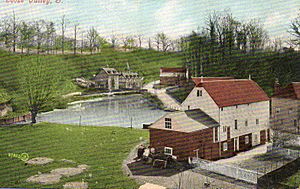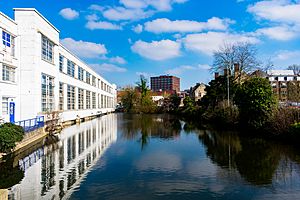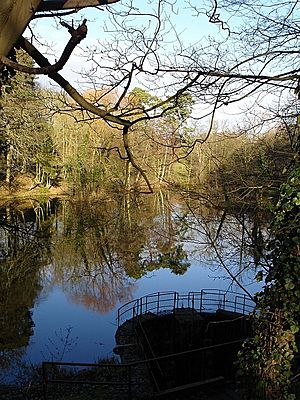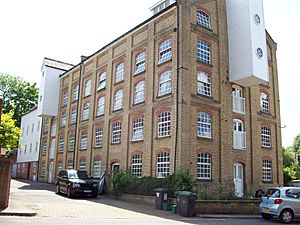Medway watermills (lower tributaries) facts for kids
The River Medway and its smaller rivers have been used for power for over 1,150 years! More than 200 places along these rivers once used the force of water to make things work.
Water power helped with many different jobs. It was used for grinding corn, making cloth thicker (called fulling), producing paper, melting iron, pumping water, making gunpowder, getting oil from vegetables, and even generating electricity.
Today, only one watermill still works for business. Most of the others have been changed into new things. Some are now homes, restaurants, museums, or even places for weddings. Many watermills are just old, broken buildings, or only their lower walls remain. For most of them, there's nothing left to see at all.
Many smaller rivers flow into the River Medway. This article will tell you about the watermills on these smaller rivers, starting from where they begin and moving towards where they join the Medway. We'll talk about the mills on the rivers that join the Medway below Yalding.
Contents
- Wateringbury Stream Mills
- West Farleigh Stream Mill
- Loose Stream Mills
- Brishing Court Mill, Boughton Monchelsea
- Leg-o-Mutton (Wilson's) Mill, Loose
- Old (Gurney's) Paper Mill
- Loose Village Watermill
- Little Ivy Mill
- Great Ivy Mill
- Bockingford Mill
- Hayle Paper Mill, Tovil
- Upper Crisbrook Mill
- Lower Crisbrook Mill
- Upper Tovil Mill
- Lower Tovil Mill (Allnut Mill)
- Bridge Mill
- Loose Stream Tributary Mill
- River Len Mills
- Polhill (Holme) Mill, Harrietsham
- Chegworth Mill, Ulcombe
- The Mille, Broomfield
- Le Mille, Broomfield
- Leeds Castle Mill, Broomfield
- Keepers Cottage Mill, Broomfield
- Old (Boxley, Hollingbourne, Hurst, Mote Hole) Mill, Leeds
- Brandescombe (Buscombe, Fulling) Mill, Leeds
- Thurnham (Ballard's) Mill
- Thurnham Mill
- Otham Mill
- Otham Paper Mill
- Poll (Pole, Mote) Mill, Boxley
- Turkey Mill, Boxley
- Christian's Mill, Maidstone
- Padsole (Lenworth) Mill, Maidstone
- Church Mill, Maidstone
- Little Church Mill, Maidstone
- Selesbourne (Len Tributary) Mill
- The Fair Bourne (Len Tributary) Mill
- Hollingbourne Stream or Snagbrook (Len Tributary) Mills
- Leeds Stream (Len Tributary) Mills
- Bearsted Stream (Len Tributary) Mills
- Cossington Stream Mill
- East Malling Stream Mills
- Boxley Stream Mill
- Addington Brook Mills
- Holborough Stream Mill
- Images for kids
Wateringbury Stream Mills
The Wateringbury Stream flows into the Medway from the left side at Wateringbury. Even near its start, there are signs that water power was used here a long time ago.
Swanton Valley's Old Mill Site
A large pond high up in the Swanton valley might show where an old furnace mill once stood. The water falling from this height would have been enough to power a large overshot waterwheel.
Mereworth Mill's History
The Domesday Book, a very old record from 1086, mentions two mills at Mereworth. The last mill here was located on the grounds of Mereworth Castle. In 1460, Thomas Hunte owned the mill. By 1521, it was a fulling mill, used for making cloth. The mill was torn down by 1907. Today, a waterfall marks the spot where it once stood. The water drop was about 8 to 10 feet (2.4 to 3 meters), which means it likely used a high breast shot or overshot waterwheel.
Wateringbury's Lost Mills
The Domesday Book also recorded three mills at Wateringbury. Two were owned by Ralf, son of Turald, and another by Hugh de Braibourne. One of these mills was shown on a map in 1822 but was not mentioned in a survey just six years later, meaning it was likely gone by then.
Brattle (Upper) Mill, Wateringbury
Brattle Mill was a corn mill, meaning it ground grain into flour. It was named after a miller, Robert Brattle, who owned it in 1783. The mill was later owned by Harry Blaker and then James Fremlin.
The original waterwheel was made of wood and was an overshot type (water flowed over the top). Around 1910, a turbine replaced the wheel, and the mill stopped grinding corn. It was then used to make electricity. This mill was sometimes called Upper Mill. In the 1980s, a large cast iron overshot waterwheel from another mill was brought here to be rebuilt. The mill originally had three pairs of millstones for grinding.
Warden Mill, Wateringbury
Warden Mill was another corn mill, named after Warden Farm. It was first mentioned in 1822. Over the years, it had several owners, including John Selby and James Fremlin. The mill pond was about three-quarters of an acre. The mill stopped working in 1913 and was torn down around 1914. The water drop was about 8 feet (2.4 meters), suggesting it used a breast shot waterwheel (where water hits the wheel near the middle).
West Farleigh Stream Mill
A stream starts at West Farleigh and flows into the Medway from the right side, just above Teston Lock. This stream powered one watermill.
Tutsham Oil Mill, West Farleigh
This mill might have been mentioned in the Domesday Book. Later, it became an oil mill, used for extracting oil from plants. It burned down on April 17, 1885. A turbine powered it. Today, only the front wall of the mill remains.
Loose Stream Mills
The Loose Stream (or River Loose) joins the Medway from the right at Tovil. Old records show that there were once many mills here. William Lambarde mentioned thirteen fulling mills and one corn mill. William Camden also noted thirteen fulling mills. By the early 1700s, the cloth trade in Kent had slowed down, so there were only two fulling mills and one paper mill. Because the stream's water was very clean, paper making became much more important in the 1800s.
Brishing Court Mill, Boughton Monchelsea
The old Brishing Court estate might have had a mill, but there isn't much proof. If it did exist, it was probably torn down by the mid-1700s.
Leg-o-Mutton (Wilson's) Mill, Loose
This mill got its unusual name from the shape of its mill pond, which looked like a leg of mutton. The Wilson family owned it in the 1870s. Later, the mill was turned into three small houses, which have now been torn down. The water drop was about 12 to 15 feet (3.6 to 4.5 meters), which means it used an overshot waterwheel.
Old (Gurney's) Paper Mill
Only the foundations of this paper mill remain near Salts Lane. The mill was torn down after the First World War. It had a large overshot waterwheel, about 15 feet (4.5 meters) in diameter and 9 feet (2.7 meters) wide.
Loose Village Watermill
This was a corn mill, probably the one mentioned by Lambarde. It had an overshot waterwheel that powered three pairs of millstones. It worked until the First World War but was later torn down.
Little Ivy Mill
In the 1500s, this mill was connected to the Pymps Court estate and was a fulling mill. Later, it became a paper mill, and then a corn mill. In 1912, it was changed into a house, and its waterwheel and machinery were removed.
Great Ivy Mill
This mill was first a fulling mill, then a paper mill. Its overshot waterwheel was replaced by a turbine, but the channel that fed water to the wheel remained. Paper making stopped here before the First World War.
Bockingford Mill
This mill was once a fulling mill, but by the mid-1800s, it was used for grinding corn. The current building was built around 1880 and last worked around 1892. The mill was later expanded and turned into a house. The mill pond was quite large, about 300 feet (91 meters) long and 70 feet (21 meters) wide. The frame of the cast iron waterwheel, about 12 feet (3.6 meters) in diameter and 8 feet (2.4 meters) wide, is still under the building.
Hayle Paper Mill, Tovil
This spot has been home to a mill for many centuries. The last mill here was a paper mill, built in 1808, famous for its handmade paper. The Green family owned it from 1817 until it closed in 1987.
In 1905, Herbert Green, the mill owner, worried that smoke from a planned railway would harm his paper. He was happy when the railway had to build a much longer tunnel, hoping it would never be built!
The mill house burned down in 2003, but the mill itself survived. The house was rebuilt as part of turning the mill into apartments. The waterwheel is unusual because it could use water in two different ways (pitchback and high breast shot). It was made by 'F. Clark, Millwright, Ashford' in 1875.
Upper Crisbrook Mill
This mill, built in the 1600s, later had a cast iron overshot waterwheel that powered pumping machines. It worked until the 1960s. The old waterwheel was restored, and the mill buildings were turned into houses around 1975. Both Crisbrook mills belonged to the church leaders in Canterbury.
Lower Crisbrook Mill
This mill, from the late 1700s, was a corn mill around 1719. It had an overshot waterwheel that powered four pairs of millstones. The mill last worked in 1905, and its machinery was removed about 30 years later. Only parts of the walls remain today.
Upper Tovil Mill
This mill was first a fulling mill, then a paper mill. It had an overshot waterwheel but burned down in 1894. The rebuilt mill used steam power. The site was cleared in the 1980s for new houses.
Lower Tovil Mill (Allnut Mill)
This was also a fulling mill, then a paper mill. Its large overshot waterwheel was removed in 1941, but paper making continued after the war. All the buildings have been torn down and replaced with houses.
Bridge Mill
Bridge Mill was originally a fulling mill, then a corn mill. In the 1700s, it became a powder mill, and later an oil mill. Finally, Bridge Mill was a paper mill, stopping work in the late 1900s. The site has been cleared for new houses.
Loose Stream Tributary Mill
Upper Mill, Loose
This mill was first a fulling mill, then a paper mill, and finally a corn mill. It had an overshot waterwheel that powered three pairs of millstones. The Wilson family owned it in the 1870s. It closed in 1908 and has since been torn down.
River Len Mills
The River Len flows into the Medway from the right side at Maidstone. It powered several watermills, from its source to its mouth.
Polhill (Holme) Mill, Harrietsham
This mill is mentioned in the Domesday Book. It was known by different names over the centuries. In 1668, it was a fulling mill. Around 1700, it was changed into a corn mill. The mill collapsed by the time a historian named Coles Finch visited it and was torn down in 1929. However, the waterwheel and the channel that fed it water still exist.
Chegworth Mill, Ulcombe
Chegworth Mill was probably not the mill mentioned in the Domesday Book for Ulcombe, but it was definitely working by 1317. It was known as the Lower Mill in 1657.
The current mill was a corn mill and worked until the late 1960s. It has a large overshot waterwheel made by Weeks of Maidstone. This wheel powered three pairs of millstones, which ground different types of grain. It also drove other machines like a "Ureka" winnower (which separates grain from chaff) and an oat crusher. The mill was converted into a house around 1990.
The Mille, Broomfield
This mill might be a Domesday site. It was shown on a map in 1649, but by 1748, only the water channels were marked, not the mill building. The water drop was about 10 feet (3 meters), suggesting a breast shot or overshot waterwheel.
Le Mille, Broomfield
This mill was first mentioned in 1368 as a fulling mill. It was marked on a map of Leeds Castle in 1649. It seems to have stopped working sometime after the 1660s. It likely had a breast shot or overshot waterwheel.
Leeds Castle Mill, Broomfield
A mill was recorded at Broomfield in the Domesday Book, even before Leeds Castle was built. It was originally a corn mill, but there's some evidence it became a fulling mill by 1368. The mill building that still exists is from the early 1200s and stopped being used in the mid-1600s. The waterwheel was powered by the lake near the castle and was a breast shot type.
Keepers Cottage Mill, Broomfield
This might have been a mill site, with a building shown on a 1748 map. However, if a mill was here, it probably disappeared in the late Middle Ages.
Old (Boxley, Hollingbourne, Hurst, Mote Hole) Mill, Leeds
This mill was on the border between Hollingbourne and Leeds. In 1654, it was a fulling mill. By 1723, the fulling mill was gone. In 1733, James Whatman got permission to build a new house and paper mill here. It was a paper mill until at least 1847, but then it became a corn mill by 1852.
In 1908, the mill was used to grind cocoa beans. It probably stopped working by 1922. The mill was five stories tall and had a large overshot waterwheel that powered six pairs of millstones. The machinery was removed during World War II, and the mill was torn down around 1955.
Brandescombe (Buscombe, Fulling) Mill, Leeds
This mill was given to the Priory of Leeds by Robert de Crevecoeur the Younger. It was a corn mill in 1177. When Leeds Priory closed in 1539, the mill still belonged to them. By 1628, it was a fulling mill. The mill was still working in 1798. It likely had a breast-shot waterwheel because the water drop wasn't high enough for an overshot wheel. The mill stopped being used by 1843. The building that remains is from the 1400s.
Thurnham (Ballard's) Mill
This was a Domesday mill, located upstream from the current mill. In 1635, it was two corn mills and a fulling mill. By 1685, fulling had stopped. The mill was known as Ballard's Mill in 1815. The mill pond was long, and the dam was about 7 feet (2.1 meters) high, meaning the waterwheel was breastshot. Ballard's mill was torn down around 1828, and a new mill was built downstream.
Thurnham Mill
This mill was built in the late 1820s. The water channel from Ballard's Mill was extended to get enough height to power a large overshot waterwheel. This waterwheel powered four pairs of millstones. The Blinkhorn family were millers here for a long time. A new waterwheel was put in after World War I. The mill worked until World War II, when the waterwheel's axle broke. Most of the machinery was then removed. The mill was sold in 1986 to be converted into a house.
Otham Mill
Also known as Bearsted Mill, this corn mill was built in 1837. It was still standing in 1939 and had an overshot waterwheel.
Otham Paper Mill
This mill was first built as a fulling mill in 1527. It was designed to have two overshot waterwheels. By 1700, it had been changed into a paper mill. A paper-making machine was installed, but later moved to Turkey Mill in 1859. The mill was then used to clean and prepare rags for paper making.
Poll (Pole, Mote) Mill, Boxley
This mill was also built as a fulling mill in 1527, with two overshot waterwheels. By 1700, it was a paper mill. Like Otham Paper Mill, it was used by the papermakers at Turkey Mill and later converted to clean rags for paper.
Turkey Mill, Boxley
This mill was originally a fulling mill, used from 1640 to 1671. It was also known as Overloppe Mill and Gill's Mill. It was changed from a fulling mill to a paper mill while John Cripps owned it. The name Turkey Mill was first used in 1739.
James Whatman acquired the mill and developed 'wove' paper here, which was a new and important type of paper. At this time, Turkey Mill was the largest paper mill in the country. The mill was sold in 1792 for a large sum of money. It remained a paper mill for over 280 years, the longest of any paper mill in Great Britain, until it closed in 1976.
- Famous Uses of Turkey Mill Paper:*
- The artist Thomas Gainsborough used paper from this mill for his drawings.
- J. M. W. Turner and William Blake also used Whatman Paper.
- Napoleon wrote his will on Whatman Paper.
- Queen Victoria used it for her personal letters.
- In the 1930s, Soviet leaders used Whatman Paper to publish their five-year plan.
- At the end of World War II, the peace treaty with Japan was written on Whatman Paper.
Christian's Mill, Maidstone
This was a fulling mill. It was torn down by 1735 and replaced by six houses. A nearby cottage, now gone, was called Fulling Mill House and had the date 1567 on it.
Padsole (Lenworth) Mill, Maidstone
This mill might be a Domesday site and was located in Water Lane. It was one of two mills in Maidstone owned by the church in Canterbury. In 1449, it was known as Poll Mill (a fulling mill). By 1548, it had two wheat mills, two fulling mills, a malt-mill, and two potchers (machines for beating rags). The mill was old and broken by the late 1700s and later torn down.
It was rebuilt in 1795 as a paper mill. The mill was torn down again in 1874, and a new corn mill was built nearby. The last mill building was a three-story brick structure and survived until the 1980s, though it no longer used water power.
Church Mill, Maidstone
Church Mill was one of two mills in Maidstone owned by the church in Canterbury. It might be one of the five mills recorded in Maidstone in the Domesday Book. It was standing in 1572. In 1752, an inventory showed it had two pairs of French Burr millstones and one pair of Peak millstones. The mill was torn down in 1903 to make way for a road, but its millpond still exists.
Little Church Mill, Maidstone
This mill was on a water channel that bypassed Church Mill. In 1752, it had one pair of French Burr millstones and four bolting mills (for sifting flour). It was torn down in the early 1800s.
Selesbourne (Len Tributary) Mill
Mill at Harrietsham
This was a grinding (corn) mill.
The Fair Bourne (Len Tributary) Mill
Fairbourne Mill, Harrietsham
This mill was probably a Domesday mill. It was first definitely mentioned in 1580. In 1768, it was described as "two water corn mills under one roof." The mill was rebuilt in 1796. This corn mill had an overshot waterwheel that powered two pairs of millstones. Milling stopped at Fairbourne in 1908, and the waterwheel was later replaced by a turbine. The mill building still stands, but it's empty of machinery.
Hollingbourne Stream or Snagbrook (Len Tributary) Mills
The Hollingbourne Stream starts at the foot of the North Downs and flows for about 1.25 miles (2 km) to the River Len. It powered four mills. It's also known as the Snagbrook or Snakebrook.
Manor Mill
A mill might have been on this site since 980 and almost certainly since the Domesday Book. The mill and house were rebuilt in 1880. The main axle of the watermill broke in 1925, ending its working life. The mill had an overshot waterwheel that powered three pairs of millstones. The mill building still exists with its waterwheel, but without machinery.
Eyhorne Mill
This corn mill might have been owned by Edward Laws in 790. It was working in 1839. It stopped working sometime between 1885 and 1898, when it was marked as disused on maps. The waterwheel was probably breastshot because the water drop was only about 6 or 7 feet (1.8 to 2.1 meters).
Grove (Cotteram's, Old) Mill
This was probably a corn mill first, then a fulling mill. During the 1700s and 1800s, it was a paper mill. By 1847, it was a corn mill again. It was later recorded as a paper mill in 1876, but a miller was still working there in 1882. The mill worked until at least 1885. The building was later torn down.
Park (New) Mill
This mill was also probably a corn mill first, then a fulling mill, and later a paper mill. A new paper mill was insured here in 1762. In 1847, this mill was making pasteboard. It was later known as Park Mill. A paper-making machine from this mill was sold in 1892. The mill was later torn down. The waterwheel was probably breast-shot and about 12 feet (3.6 meters) in diameter.
Leeds Stream (Len Tributary) Mills
Le Nethertoune Mill, Leeds
This mill probably had a breastshot or undershot waterwheel because the water drop was only about 4 feet (1.2 meters). It was a fulling mill that was recorded as being "in ruins" in 1466.
Abbey Mill, Leeds
This was probably a Domesday site and one of five mills owned by the people of Leeds. Leeds Priory closed in 1539. The mill had a cast iron overshot waterwheel made by Weeks of Maidstone. This waterwheel powered three pairs of millstones. The mill was old and broken but still mostly there in 1936, but later partly torn down. Some machinery still remains inside.
Priory (North) Mill, Leeds
This mill was first recorded as belonging to King James I in 1608. Only a few parts of the mill walls remained by 1834. The water drop would have been around 5 feet (1.5 meters), suggesting a breastshot waterwheel.
Bearsted Stream (Len Tributary) Mills
A stream starts above Bearsted and powered two mills.
Aldington Mill, Thurnham
Aldington Mill was a Domesday mill, mentioned in records from 1269.
Lower Milgate Mill, Bearsted
This mill was part of a small estate. It existed in the early 1700s and appeared on maps from that time.
Cossington Stream Mill
A stream starts at Cossington and flows into the Medway from the right at Aylesford. It powered one watermill.
Cossington Mill
This was a corn mill.
East Malling Stream Mills
The East Malling Stream flows into the Medway from the left at Aylesford. The Domesday Book recorded two mills at East Malling. In 1363, there were two mills in the village. East Malling had a fulling mill from 1567 to 1719. There were three mills in 1706: Upper, Weir, and Middle Mills. The history of the paper mills here is connected because they shared owners.
Upper Mill, East Malling
This mill was operating as a paper mill by 1764. It underwent a lot of development between 1840 and 1860. It was torn down between the First and Second World Wars. The mill pond was about 200 yards (182 meters) long. The mill had an overshot waterwheel, and its remains were still on site in 1972.
Weir Mill, East Malling
This was probably one of the two Domesday mills. In 1840, James Phillips owned and operated this water corn mill, which had a 12-foot (3.6-meter) waterwheel that powered two pairs of stones. The mill stopped grinding corn in 1930 and was later used for storage.
- The Surviving Mill Building:*
The original timber-clad mill building is from the time of Queen Anne. A brick part was added later. Around 1893, roller mills were installed, along with a boiler and steam engine to power them, while the waterwheel still drove the millstones. The steam engine was later sold to someone in the USA.
- The Wooden Mill:*
This part of the mill was four stories high. The 12-foot (3.6-meter) diameter overshot waterwheel powered three pairs of millstones.
- The Brick Mill:*
This part was built in two sections and was about six stories high, much taller than the original mill. It contained six roller mills.
Middle Mill, East Malling
This was probably one of the two Domesday mills. Middle Mill existed in 1684. In 1755, Richard Gowlett was the papermaker here. The mill was sold in 1798. It was used to make brown and white paper. The mill pond covered about half an acre.
Lower Mill, East Malling
In 1792, a patent was granted for using chlorine to bleach rags for paper. The owner of Lower Mill at that time had already tried this. By 1821, Robert Tassell owned both Upper and Lower Mills, making both brown and white papers. It's likely that Lower Mill stopped making paper regularly in 1848 and closed completely by 1852. The mill seems to have been torn down by 1860. The mill pond is quite large, about 200 yards (182 meters) long and 50 yards (45 meters) wide.
Church Mills, Ditton
This was a Domesday site, with one mill recorded at Ditton. This corn mill closed around 1912. It was located near a ford in Bradbourne Lane. In its later years, the waterwheel was replaced by a turbine.
Mill Hall Mill, Aylesford
This mill was shown on a map in 1684 and was a paper mill then. It had several owners over the years. By 1841, it had stopped making paper and became a corn mill. A steam engine was recorded at the mill in 1887 but was gone by 1890. The mill stopped working by 1922. The machinery was removed, and the building was turned into stables. The mill was torn down around 1950, but the waterwheel survived until 1969.
The mill was three stories high, with a stone base and timber upper stories. The overshot waterwheel was large, about 14 feet (4.2 meters) in diameter and 6 feet (1.8 meters) wide. The last parts of Mill Hall Mill were torn down to build a footbridge over the M20.
Boxley Stream Mill
A stream starts at Boxley and powered one watermill.
Sandling Mill
This mill was built as a paper mill. It was later changed into a corn mill. In 1984, it was offered for sale to be converted into a house. Planning permission was given in 1991, with the condition that the waterwheel had to be replaced. In 2005, the building burned down, leaving only its stone base.
Addington Brook Mills
A stream flows into the Medway from the left at Snodland. It powered six watermills.
Ford Place Mill, Wrotham
This was a corn mill. The 1700s building was still standing in 1932, but without machinery. The waterwheel was overshot. The mill building was torn down in 1970 to build the M26 highway.
Addington Mill
This was a corn mill, torn down in the 1800s. The site is now part of the West Malling Golf Course.
Ryarsh Mill
A Domesday site, Ryarsh Mill was a corn mill that last worked in 1930. The building was from the late 1700s. The waterwheel was overshot.
Leybourne Mill
A Domesday site, Leybourne Mill was a corn mill. The waterwheel was overshot.
Mill Site, Leybourne
(No details provided in original text, so no further information can be added.)
Ham Mill, Snodland
This was a corn mill.
Holborough Stream Mill
A stream starts above Snodland and flows into the river from the left, downstream of the Addington Brook. It powered one watermill.
Holborough Mill
This is a very old mill site. A mill was given by King Egbert I of Kent in 836. In 1100, it was valued at £1. The mill fell into disrepair in the early 1300s but was rebuilt in 1322. The mill building that still exists has a cast iron overshot waterwheel. It was a corn mill.
Images for kids

























